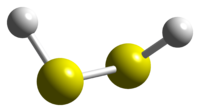- Hydrogen disulfide
-
Hydrogen disulfide 
 Dihydrogen disulfideOther namesHydrogen disulphide; Hydrogen persulfide; Hydrogen persulphide
Dihydrogen disulfideOther namesHydrogen disulphide; Hydrogen persulfide; Hydrogen persulphideIdentifiers CAS number 13465-07-1 PubChem 108196 ChemSpider 97274 
ChEBI CHEBI:33114 
Jmol-3D images Image 1 - SS
Properties Molecular formula H2S2 Molar mass 66.15 g mol−1 Appearance yellow liquid Density 1.334 g cm-3 Melting point -89.6 °C, 184 K, -129 °F
Boiling point 70.7 °C, 344 K, 159 °F
Hazards Flash point flammable Related compounds Related compounds Hydrogen peroxide
Hydrogen sulfide disulfide (verify) (what is:
disulfide (verify) (what is:  /
/ ?)
?)
Except where noted otherwise, data are given for materials in their standard state (at 25 °C, 100 kPa)Infobox references Hydrogen disulfide (H2S2) is an inorganic compound. This mal-odorous oil decomposes readily to hydrogen sulfide (H2S).
Contents
Structure
The structure of hydrogen disulfide is similar to that of hydrogen peroxide, with two central sulfur atoms and two outer hydrogen atoms. However, the skew angle of the molecule is different, as the H-S-S bond in hydrogen disulfide has a near-standard 90° torsion angle of the syn conformer.
Skew angle in the H2S2 molecule is 90.6°, compared with 113.7° in H2O2. Molecular dimensions in these two molecules are: O-O, O-H, S-S and S-H bonds have lengths of 1.490, 0.970, 2.055 and 1.352 ångströms respectively.[1][2]
Synthesis and reactions
Hydrogen disulfide can be synthesised by dissolving alkali or alkali earth metal polysulfides in water. When the solution is mixed with concentrated hydrochloric acid at −15 °C, a yellow oil consisting a mixture of polysulfanes (H2Sn) will pool below the aqueous layer. Fractional distillation of this oil gives hydrogen disulfide separate from any other polysulfides (mostly trisulfide).[3][4][5]
Hydrogen disulfide readily decomposes under ambient conditions to hydrogen sulfide and sulfur.[4] In organosulfur chemistry, hydrogen disulfide adds to alkenes to give disulfides and thiols.[6]
Health effects
Hydrogen disulfide has been described as "having a severe and irritating odour" that is similar to camphor or sulfur chloride, causing "tears and a smarting sensation in the nostrils".[4] If it is present in high concentrations, it can cause dizziness, disorientation and ultimately unconsciousness.[7]
References
- ^ Davies, D. W. (1974). "Photoelectron spectra of hydrogen peroxide and hydrogen disulfide: ab initio calculations". Chemical Physics Letters 28 (4): 520–522. doi:10.1016/0009-2614(74)80093-X.
- ^ P. Lazzeretti and R. Zanasi (1997). "On the calculation of parity-violating energies in hydrogen peroxide and hydrogen disulfide molecules within the random-phase approximation". Chemical Physics Letters 279 (5-6): 349–354. doi:10.1016/S0009-2614(97)01060-9.
- ^ De, A. K. (2001-01-15). A Text Book of Inorganic Chemistry. ISBN 9788122413847. http://books.google.com/?id=AzoCJfTmRDsC.
- ^ a b c Walton and Parson; Parsons, Llewellyn B. (1921). "Preparation and Properties of the Persulfides of Hydrogen". J. Amer. Chem. Soc. 43: 2539–48. doi:10.1021/ja01445a008.
- ^ Georg Brauer: Handbook of Preparative Inorganic Chemistry Volume I, page 391, Wiley, 1963.
- ^ Hazardous Reagents, Robinson Brothers
- ^ Stein, Wilkinson, G (2007). Seminars in general adult psychiatry. Royal College of Psychiatrists. ISBN 9781904671442.
Hydrogen compounds H3AsO3 · H3AsO4 · HAt · HSO3F · HBF4 · HBr · HBrO · HBrO2 · HBrO3 · HBrO4 · HCl · HClO · HClO2 · HClO3 · HClO4 · HCN · HCNO · H2CrO4/H2Cr2O7 · H2CO3 · H2CS3 · HF · HFO · HI · HIO · HNC · HNCO · HNO · HNO3 · H2N2O2 · HNO5S · H3NSO3 · H2O · H2O2 · H2O3 · H3PO2 · H3PO3 · H3PO4 · H4P2O7 · H5P3O10 · H2PtCl6 · H2S · H2Se · H2SeO3 · H2SeO4 · H4SiO4 · H2SiF6 · H2SO3 · H2SO4 · H2SO5 · H2S2O3 · H2S2O6 · H2S2O7 · H2S2O8 · CF3SO3H · H2Te · H2TeO3 · H6TeO6 · H4TiO4 · H2Po · H3VO4 · HCo(CO)4
Categories:- Hydrogen compounds
- Sulfur compounds
Wikimedia Foundation. 2010.
